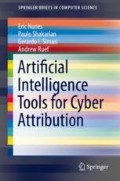Abstract
Attributing the culprit of a cyberattack is widely considered one of the major technical and policy challenges of cybersecurity. While the lack of ground truth for an individual responsible for a given attack has limited previous studies, here we overcome this limitation by leveraging DEFCON capture-the-flag (CTF) exercise data where the actual ground truth is known. In this chapter, we use various classification techniques to identify the culprit in a cyberattack and find that deceptive activities account for the majority of misclassified attacks. We also explore several heuristics to alleviate some of the misclassification caused by deception.
Access this chapter
Tax calculation will be finalised at checkout
Purchases are for personal use only
Notes
References
L. Breiman. Bagging predictors. Machine learning, 24(2):123–140, 1996.
L. Breiman. Random forests. Machine learning, 45(1):5–32, 2001.
L. Breiman, J. Friedman, C. J. Stone, and R. A. Olshen. Classification and regression trees. CRC press, 1984.
C.-C. Chang and C.-J. Lin. Libsvm: A library for support vector machines. ACM Transactions on Intelligent Systems and Technology (TIST), 2(3):27, 2011.
C. Cortes and V. Vapnik. Support vector networks. Machine learning, 20(3):273–297, 1995.
DEFCON. Capture the Flag. 2013. https://media.defcon.org/.
E. Nunes, N. Kulkarni, P. Shakarian, A. Ruef, and J. Little. Cyber-deception and attribution in capture-the-flag exercises. In Proceedings of the IEEE/ACM International Conference on Advances in Social Networks Analysis and Mining (ASONAM), pages 962–965. ACM, 2015.
Author information
Authors and Affiliations
Rights and permissions
Copyright information
© 2018 The Author(s)
About this chapter
Cite this chapter
Nunes, E., Shakarian, P., Simari, G.I., Ruef, A. (2018). Baseline Cyber Attribution Models. In: Artificial Intelligence Tools for Cyber Attribution. SpringerBriefs in Computer Science. Springer, Cham. https://doi.org/10.1007/978-3-319-73788-1_2
Download citation
DOI: https://doi.org/10.1007/978-3-319-73788-1_2
Published:
Publisher Name: Springer, Cham
Print ISBN: 978-3-319-73787-4
Online ISBN: 978-3-319-73788-1
eBook Packages: Computer ScienceComputer Science (R0)

